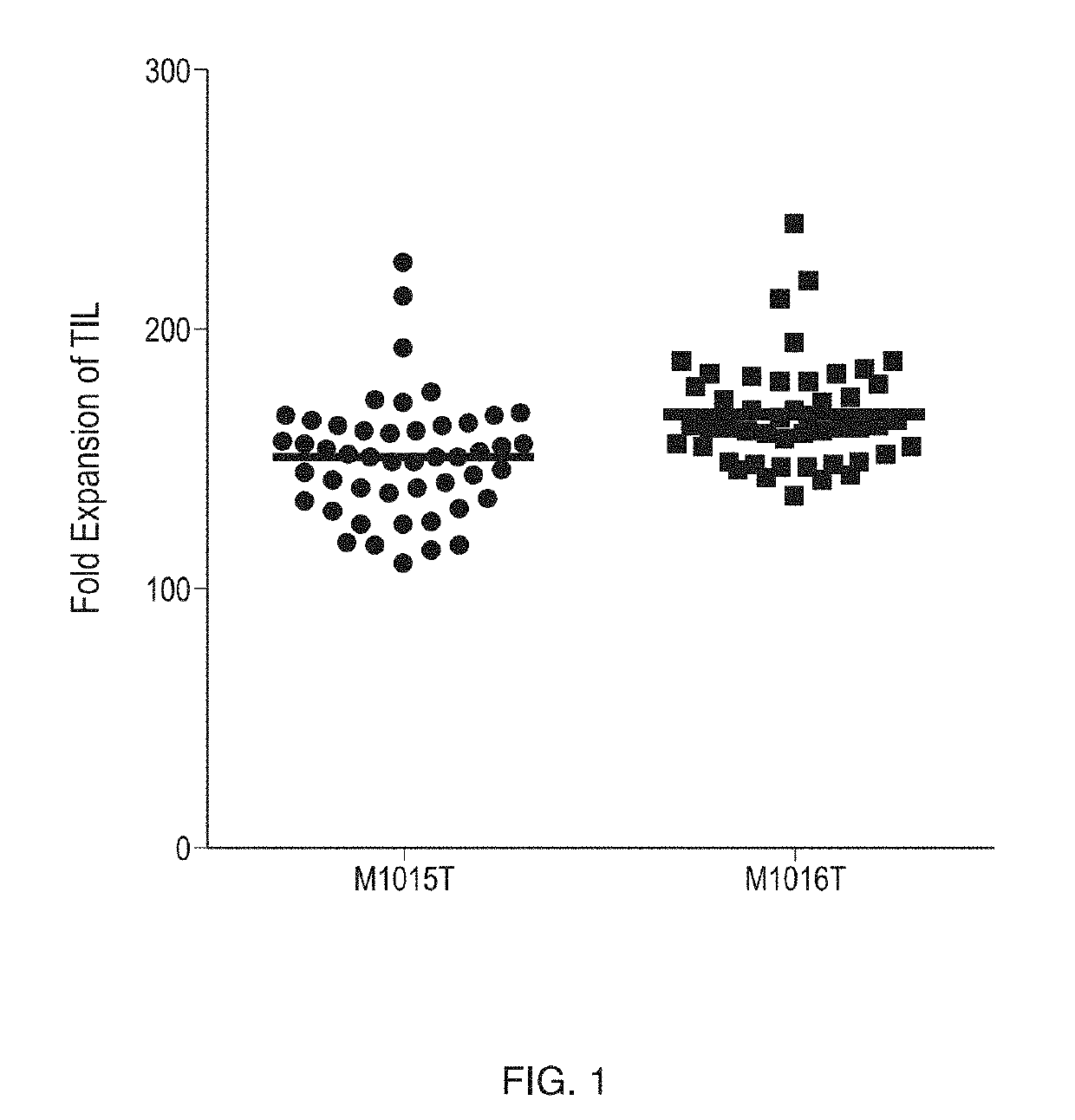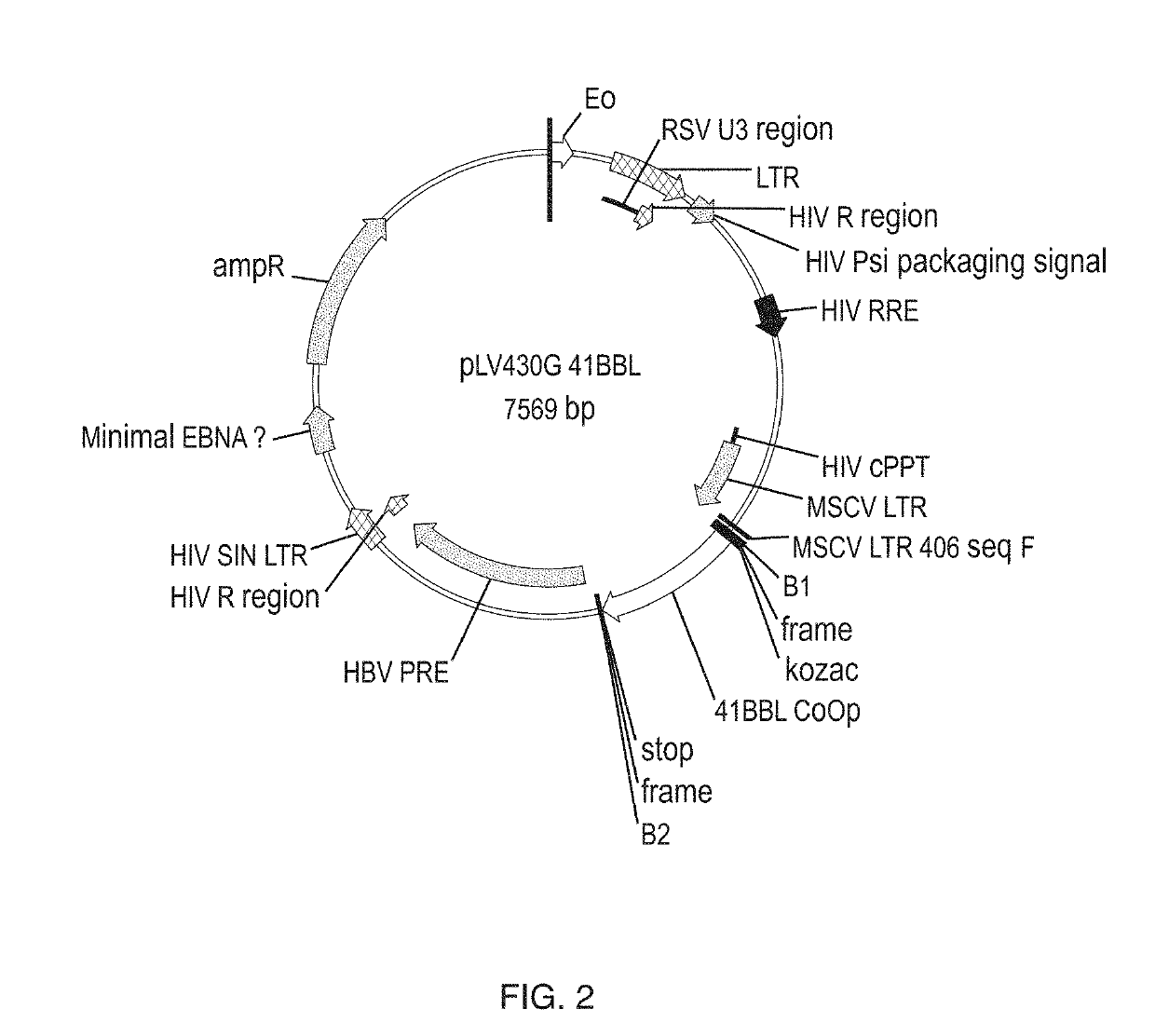Engineered artificial antigen presenting cells for tumor infiltrating lymphocyte expansion
a technology of tumor infiltrating lymphocytes and artificial antigens, which is applied in the direction of genetically modified cells, antibody medical ingredients, drug compositions, etc., can solve the problems of unfavorable patient infection downstream, the risk of undetected viral pathogens causing downstream infection, and the inability to perform extensive and costly laboratory testing of each individual donor cell product to confirm sterility,
- Summary
- Abstract
- Description
- Claims
- Application Information
AI Technical Summary
Benefits of technology
Problems solved by technology
Method used
Image
Examples
example 1
ty in Expansion of Tumor Infiltrating Lymphocytes Using PBMC Feeder Cells
[0590]The variability in TIL expansion obtained by use of PBMC feeder cells may be demonstrated by comparing the results of multiple TIL expansions on the same line of TILs obtained from a patient. FIG. 1 illustrates typical results of rapid expansion of TILs using irradiated allogeneic PBMC feeder cells (PBMC feeders). Two TIL lines labeled M1015T and M1016T (1.3×105 cells) were co-cultured with 46 different irradiated feeder cell lots (1.3×107), IL-2 (3000 IU / mL, recombinant human IL-2 (e.g., aldesleukin or equivalent), CellGenix, Inc., Portsmouth, N.H., USA) and OKT-3 (30 ng / mL, MACS GMP CD3 pure, Miltenyi Biotec GmbH, Bergisch Gladbach, Germany) in a T25 flask for 7 days. The fold expansion value for TILs was calculated on Day 7. The figure shows the number of fold expansions for the two TIL lines in separate stimulation experiments. For each TIL line, 46 different PBMC feeder lots were tested. The results ...
example 2
of Myeloid Cells for aAPC Development
[0591]Phenotypic characterization was performed on various myeloid-lineage cell lines to identify potential candidates for further modification into aAPCs for TIL expansion. The results are summarized in Table 5. The MOLM-14 cell line exhibited endogenous expression of CD64, and was selected for further development. The EM-3 cell line was selected based on the observation of endogenous expression of ICOS-L (which was not observed for the EM-2 cell line, despite being taken from the same patient).
[0592]
TABLE 5Summary of costimulatory molecules expressed endogenously on candidate cell linesfor aAPCs. CML refers to chronic myeloid leukemia, and AML refers to acute myeloidleukemia. “Pop” refers to the population of cells observed to express the marker (½ pop =50%).Cell lineK562myeloidEM-2EM-3erythro-Myeloid blastMyeloid blastKG1-246KG1-8031leukemia,MOLM-14Origincrisis, CMLcrisis, CMLAMLAMLCMLAMLHLA-A / B / C++++−+CD64−−−−−+CD80−−−−−+ICOS-L−+−−−+4-1BBL−−−...
example 3
on of MOLM-14 Artificial Antigen Presenting Cells (aMOLM14 aAPCs)
[0593]MOLM-14 cells were obtained from Leibniz-Institut DSMZ-Deutsche Sammlung von Mikroorganismen and Zellkulturen GmbH. To develop MOLM-14 based aAPCs, MOLM-14 cells were engineered with the costimulatory molecules CD86 and 4-1BBL (CD137L). Human CD86 (hCD86) and human 4-1BBL (h4-1BBL) genes were cloned into commercially-available PLV430G and co-transfected with PDONR221 vectors (Invitrogen / Thermo Fisher Scientific, Carlsbad, Calif., USA) using a lentiviral transduction method. The gateway cloning method was used as described in Katzen, Expert Opin. Drug Disc. 2007, 4, 571-589, to clone hCD86 and hCD137L genes onto the PLV430G and PDONR221 vectors. The 293T cell line (human embryonic kidney cells transformed with large T antigen) was used for lentiviral production, transduced to MOLM-14 cells. The transfected cells were sorted (S3e Cell Sorter, Bio-Rad, Hercules, Calif., USA) using APC-conjugated CD86 and PE-conjugat...
PUM
| Property | Measurement | Unit |
|---|---|---|
| Time | aaaaa | aaaaa |
| Fraction | aaaaa | aaaaa |
| Acidity | aaaaa | aaaaa |
Abstract
Description
Claims
Application Information
 Login to View More
Login to View More - R&D
- Intellectual Property
- Life Sciences
- Materials
- Tech Scout
- Unparalleled Data Quality
- Higher Quality Content
- 60% Fewer Hallucinations
Browse by: Latest US Patents, China's latest patents, Technical Efficacy Thesaurus, Application Domain, Technology Topic, Popular Technical Reports.
© 2025 PatSnap. All rights reserved.Legal|Privacy policy|Modern Slavery Act Transparency Statement|Sitemap|About US| Contact US: help@patsnap.com



